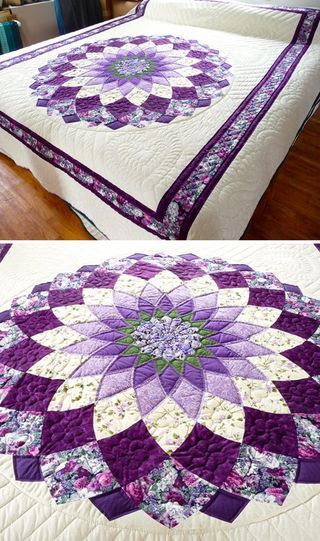Quilting is a timeless craft that allows for both creativity and practicality. Whether you’re a seasoned quilter or just starting out, finding the perfect project can be key to honing your skills and expressing your creativity.
The Giant Dahlia Quilt pattern offers an exciting opportunity for beginners to create a visually stunning piece that is sure to impress.
In this comprehensive guide, we’ll explore everything you need to know to embark on your Giant Dahlia Quilt journey, from selecting fabrics to piecing the dahlia blocks and assembling the quilt top.

Introduction to the Giant Dahlia Quilt:
The Giant Dahlia Quilt is a classic pattern that features a large, intricate dahlia flower design. Despite its complex appearance, this pattern is surprisingly beginner-friendly, making it an excellent choice for those new to quilting. The key to success with the Giant Dahlia Quilt lies in careful fabric selection, precise cutting, and accurate piecing techniques.
Materials Needed:
Before diving into your Giant Dahlia Quilt project, it’s essential to gather all the necessary materials. Here’s what you’ll need:
- Fabric: Choose a variety of fabrics for your quilt top, including a background fabric and fabrics for the dahlia petals. Consider using a mix of solids and prints to add depth and dimension to your quilt.
- Batting: Select a batting that suits your preferences for warmth and weight. Cotton batting is a popular choice for quilts.
- Backing Fabric: Choose a fabric for the back of your quilt that complements the colors and patterns in your quilt top.
- Thread: Use high-quality thread that coordinates with your fabric choices.
- Ruler and Rotary Cutter: Essential tools for accurately cutting fabric pieces.
- Sewing Machine: While you can hand-piece your quilt, using a sewing machine will speed up the process.
- Quilting Pins or Clips: To hold fabric pieces together during sewing.
- Iron and Ironing Board: Essential for pressing seams and achieving crisp, flat quilt blocks.
Choosing Fabrics:
The key to a successful Giant Dahlia Quilt lies in careful fabric selection. Choose fabrics that contrast with each other and complement the overall color scheme of your quilt. For the dahlia petals, consider using fabrics with a gradient effect or subtle variations in color to create depth and dimension. For the background fabric, opt for a neutral color that will allow the dahlia to take center stage.
Piecing the Dahlia Blocks:
The Giant Dahlia Quilt pattern features a series of dahlia blocks that are pieced together to create the quilt top. Each dahlia block consists of multiple petal units that are sewn together in a circular pattern. Here’s how to piece the dahlia blocks:
- Cutting Fabric:
- Begin by cutting fabric strips according to the pattern instructions. These strips will be used to create the petal units for the dahlia blocks.
- Use a ruler and rotary cutter to ensure accurate measurements.
- Creating Petal Units:
- Fold each fabric strip in half lengthwise, right sides together, and sew along the long edge using a ¼-inch seam allowance.
- Turn the strip right side out and press flat to create a tube.
- Use a ruler and rotary cutter to cut the tube into individual petal units of equal width.
- Assembling Dahlia Blocks:
- Arrange the petal units in a circular pattern to create the dahlia block.
- Sew the petal units together, pressing seams open to reduce bulk and ensure flat blocks.
- Repeat the process to create multiple dahlia blocks according to the quilt pattern’s specifications.
Assembling the Quilt Top:
Once you’ve pieced all the dahlia blocks, it’s time to assemble the quilt top. Arrange the blocks in rows, alternating the orientation of the blocks to create visual interest. Sew the blocks together, pressing the seams open as you go. Add borders to the quilt if desired, then trim any excess fabric to square up the edges.
Quilting and Finishing:
With the quilt top complete, it’s time to quilt and finish your Giant Dahlia Quilt. Layer the quilt top with batting and backing fabric, then baste the layers together using quilting pins or clips. Quilt as desired, either by hand or using a sewing machine. Popular quilting techniques for the Giant Dahlia Quilt include straight-line quilting, free-motion quilting, or echoing the dahlia design.
After quilting, trim any excess batting and backing fabric, then add binding to the edges of the quilt to finish it off. Hand-stitch the binding to the back of the quilt for a clean, professional finish.
Conclusion:
Creating a Giant Dahlia Quilt is a rewarding project that’s perfect for beginners. With its stunning design and approachable piecing techniques, this quilt pattern is sure to become a treasured heirloom for years to come. So gather your materials, fire up your sewing machine, and embark on your quilting journey today!




